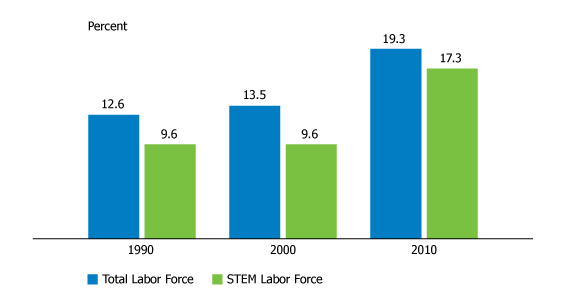
U.S. STEM Workforce Aging, but Younger Than Total Labor Force
(April 2013) The U.S. population and its labor force are growing older, but according to PRB’s analysis of American Community Survey data, the STEM (Science, Technology, Engineering, and Math) labor force is faring better than the total U.S. labor force with respect to age structure.1 The percent of workers ages 55 and older has been higher in the total labor force than in the STEM labor force for at least two decades (see figure).
Percent of U.S. Labor Force Ages 55 and Older, 1990-2010

Source: PRB analysis of American Community Survey Public Use Microdata (PUMS), U.S. Census Bureau.
While the current STEM labor force has a smaller share of workers ages 55 and older than the total U.S. labor force, this may soon change. In 2010, 23 percent of the total U.S. labor force was ages 45 to 54, compared to 25 percent of the STEM labor force. This means that aging in the STEM labor force is expected to outpace the aging in the total labor force in the near future. A shortage of STEM workers is not an immediate concern, but is one that could pose challenges in the next 10 to 20 years.
Regional Differences
While 18 percent of STEM workers were age 55 or older nationwide in 2011, STEM workers were considerably older in some cities. In Colorado Springs, 27 percent of the STEM labor force was age 55 or older. Other cities with aging STEM workers included Arlington, TX (26 percent), Tulsa (23 percent), Detroit and Tucson (21 percent each), and Las Vegas and Omaha (20 percent each). The cities with the lowest percentage of STEM workers ages 55 and older were Boston and Atlanta with only 7 percent; Washington, DC (8 percent); and Chicago, San Antonio, and Seattle with 9 percent each. Generally, cities with large universities tended to have younger STEM workers.
Cities with the highest shares of STEM workers age 65 and older in 2011 were Colorado Springs, Detroit, and Las Vegas, each with 6 percent, well above the national average of 3 percent.
Changing Racial/Ethnic Composition
As the STEM labor force ages, it is also growing more diverse. However, the STEM labor force has long had a larger share of non-Hispanic whites than the total U.S. labor force. In 2000, non-Hispanic whites made up 73 percent of the total labor force, compared with 77 percent of the STEM labor force. Among those ages 55 and older, the total U.S. labor force age 55 and older was 82 percent non-Hispanic white, while the STEM labor force age 55 and older was 87 percent non-Hispanic white.
By 2010, the share of non-Hispanic whites in the labor force had declined sharply. Non-Hispanic whites made up 66 percent of the total labor force and 71 percent of STEM workers. The U.S. labor force ages 55 and older was 77 percent non-Hispanic white in 2010, compared with 83 percent among the STEM labor force.
Maintaining America’s position as a world leader in science may be difficult in the coming years as a growing share of workers age out of the labor force. Increases in worker productivity and automation have alleviated the upcoming shortage of workers, but America’s main strategy to maintain the pipeline of STEM workers historically has been opening our doors to highly skilled migrants, mostly from Asia.2 The United States has long been an attractive destination for young migrants from other countries interested in pursuing a STEM education or career, but this could change depending on future economic trends, changes in U.S. immigration policies and priorities, and the availability of new job opportunities in traditional sending countries such as China and India.
Furthermore, relying on immigration alone may not be enough to offset the large number of scientists and engineers who will soon be exiting the STEM labor force. Encouraging STEM careers among populations who have not entered the STEM labor force in large numbers in the past, such as women, blacks, and Hispanics, would help fill the upcoming shortage of workers in science and engineering occupations as existing workers begin to retire. Companies may need to take a more active role in training future workers to keep the United States competitive in the new, knowledge-based global economy.
Diana Lavery is a research associate in Domestic Programs at the Population Reference Bureau.
References
- The science and engineering labor force includes people employed or unemployed in computer-related occupations, engineering, architecture, life science, physical science, and social science occupations. This is a broader classification than that used by many other organizations, including the National Science Foundation.
- Christine Gambino and Thomas Gryn, “The Foreign Born With Science and Engineering Degrees: 2010,” American Community Survey Briefs (November 2011).
